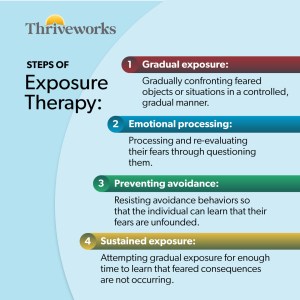Throughout our lives, we will all face certain amounts of anxiety and fear. However, when anxiety and fear begin to control someone’s life, even keeping them from going to different places or participating in certain experiences, therapeutic intervention may be necessary.
When someone is plagued by intense anxiety in safe, everyday situations, qualified clinicians will often employ exposure therapy to help with their symptoms. This type of therapy helps lessen anxiety by making individuals face their fears, showing them that the consequences they fear aren’t realistic.
What Is Exposure Therapy?
Exposure therapy is the gradual exposure to a feared stimulus with the goal of facing or conquering one’s fear and creating a new relationship with anxiety and/or fear. This kind of exposure allows individuals to learn to navigate fear and anxiety with productive tools and coping skills so that it feels less distressing over time.
Many people with anxiety disorders and other mental health conditions find themselves forced to avoid certain places or environments in order to function normally. Exposure therapy helps them work through this anxiety by slowly and steadily putting themselves in fear-inducing everyday spaces in order to help them face their fears and show them that these scenarios are safe and not harmful.
The four steps of exposure therapy are the following:
- Gradual exposure: Gradually confronting the feared object or situation in a controlled, gradual manner. It starts with less anxiety-provoking situations and gradually progresses to more challenging ones as the individual conquers their fear.
- Sustained exposure: An individual is exposed to the feared object or situation for a sufficient duration, allowing for enough time to observe and learn that the feared consequences do not occur.
- Preventing avoidance: During exposure therapy, individuals are encouraged to resist engaging in avoidance behaviors. An example of an avoidance behavior may be avoiding elevators. Avoidance only perpetuates anxiety and prevents the individual from learning that their fears are unfounded.
- Emotional processing: Throughout the process of exposure therapy, individuals are guided to actively process and re-evaluate their fears and anxieties. They ask themselves questions: “Is my fear realistic? Is it valid? Is my fear still present as I build up experience exposing myself to the scary thing or situation?” Individuals are encouraged to challenge and replace negative thoughts with more realistic and adaptive ones, facilitating a change in their emotional response.
Following these steps is effective for helping people realize that their anxiety or anxious thoughts are not always true, despite their bodily reactions trying to tell them otherwise. Through this, they can learn to stop avoiding their unfounded fears and live a life unencumbered by them.

What Does Exposure Therapy Work Best for?
Exposure therapy works best for treating obsessive-compulsive disorder (OCD), specific phobias, social anxiety disorder, panic disorder, post-traumatic stress disorder (PTSD), and even generalized anxiety disorder (GAD).
With many of these disorders, intense bouts of anxiety can occur in certain places or situations. With some, like PTSD and specific phobias, this anxiety might be tied to past experiences, causing irregular amounts of fear to occur in seemingly normal situations that remind an individual of their past trauma.
However, with panic disorder and sometimes generalized anxiety disorder, these bouts of anxiety can occur seemingly out of nowhere.
In any of these cases, this intense anxiety causes people to avoid certain environments in order to keep themselves from experiencing anxiety or panic attacks, inhibiting their ability to move about the world and live a normal life. Exposure therapy would then have them confront these scenarios and places so that they can learn to exist in them with much more reduced levels of anxiety, or even none at all.
What Is the Most Common Type of Exposure Therapy?
One of the most common therapeutic approaches involved in exposure therapy is cognitive behavioral therapy (CBT). CBT is often utilized to challenge and replace negative thoughts, such as fears of everyday spaces, with more realistic and adaptive ones.
Is Exposure Therapy a Type of CBT?
CBT can involve exposure therapy through the use of exposure and response intervention (ERP), which is another name for exposure therapy. When used in CBT, it is an intensive form of behavior therapy involving exposing individuals to situations or cues that trigger intrusive and distressing thoughts or provoke repetitive behaviors. Once exposed to these scenarios, the individual has to practice abstaining from the compulsive behavior.
What Are the 4 Principles of Exposure Therapy?
The four principles of exposure therapy are:
- Habituation: This principle holds that repeated exposure to a problematic stimulus will lessen the reaction to it over time.
- Extinction: This theory states that, when fear of specific stimuli is a learned behavior, exposure to that stimuli will weaken the associations between the original event and similar stimuli.
- Emotional processing: This is the process of sorting through an individual’s feelings and thoughts associated with the feared stimuli and working to replace those associations with more accurate expectations.
- Self-efficacy: This theory focuses on showing an individual that they can control how they respond to the feared stimuli by allowing them to confront it.
Each of these has an important place in the process and efficacy of exposure therapy.
What Are the Cons of Exposure Therapy?
The main possible con of exposure therapy is the fact that exposure to one’s fear is an uncomfortable and distressing experience. It is not easy facing your fears, even if you do so in a controlled, safe, and therapeutic environment. You should expect to feel some discomfort, but not full-blown distress or panic symptoms.
However, remember — if this idea makes you balk at exposure therapy, keep in mind that you are already experiencing or liable to experience the full force of this fear any time you are around your feared stimulus. Though this will still make you experience it in small doses, it will help lower your anxiety over time.
A therapist trained in exposure therapy will be able to help you work through gradual exposure to a feared stimulus with a plan to work up to facing your fears with tools, skills, or techniques to help you keep your anxiety at bay. It is important to stay committed to exposure and response prevention (ERP) and not expect instant results or overnight results. Good things take time.
Hello, we're here to help you
We provide award-winning mental health services nationwide, with flexible scheduling & insurance coverage. Start your journey this week.
Is Exposure Therapy the Best for Anxiety? Can Exposure Therapy Make Anxiety Worse?
If exposure therapy is done in a way that’s too much too fast, then yes, it can make anxiety worse. That’s why it’s important that you work with a mental health professional trained in exposure and response prevention (ERP) and allow them to lead you through the exposure therapy process.
They will make sure that you follow the proper steps of exposure therapy and not rush exposure in order to try and speed up recovery. Though exposure is a good way to work through fear, prolonged or overwhelming exposure to a phobia or fear, also called “flooding,” is not advisable. Gradual exposure is necessary to work through anxiety in a healthy and effective way.
Is Exposure Therapy the Only Way to Help OCD?
Exposure therapy is not the only way to help OCD, but it is certainly an effective way. CBT alongside ERP is often the gold standard in treating OCD.
With the help of exposure therapy and the formula of the four principles, an individual’s fear can subside and they will no longer have to use the maladaptive behaviors or compulsions that previously had to manage their anxiety and, as a result, dominated their life.
However, exposure therapy takes time, practice, and a great deal of patience to see the results. Sometimes, the results seem slow-moving at first, but they will come with consistent practice.
How Long Does It Take Exposure Therapy to Work?
The duration of exposure therapy for individuals can depend on a variety of factors, such as the severity and nature of the condition being treated, the individual’s response to treatment, and the specific treatment plan developed by the client and therapist.
Because everyone responds to therapy differently, the total duration of exposure therapy can range from a few weeks to a few months or longer.
What Are the Benefits of Exposure Therapy?
The main benefit of exposure therapy is that, eventually, you will no longer feel powerless over your anxiety. It can give you the freedom to walk through life alongside your anxiety rather than constantly warring with it.
Exposure therapy is thought to help in several other ways, including:
- Habituation: Over time, people find that their reactions to feared objects or situations decrease.
- Extinction: Exposure can help weaken previously learned associations between feared objects, activities, or situations and bad outcomes.
- Rewiring the brain: When we get anxious, a fear-inducing situation activates a small group of neurons in the amygdala. Exposure therapy silences these fear neurons, causing them to be less active. As a result of this reduced activity, fear responses are alleviated.
If you struggle with anxiety or irregular amounts of fear caused by a mental health condition, speak with a mental health professional about your symptoms. They can assess your situation and work with you to create an effective treatment plan for your condition.













